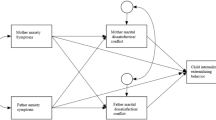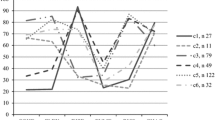Abstract
This study examined relationships among marital quality, family patterns, and children's fears, and social anxiety. Two types of family patterns were studied, adaptability and cohesion. Mothers of children aged 5–6, drawn from kindergartens in northern Israel, completed Hebrew versions of the ENRICH scale (abridged, for marital quality), FACES-III (adaptability and cohesion), the FSSC-R (fears), and the SASC-R (social anxiety). Family cohesion was negatively correlated with marital quality and positively correlated with children's social anxiety. Marital quality and family adaptability were inversely related to specific children's fears. Children's social anxiety was highly correlated with specific fears. These findings suggest that children from rigid, fused families or low quality marriages may be at risk for high levels of fears and social anxiety.
Similar content being viewed by others
References
Adalbjarnardottir, S. (1995). How schoolchildren propose to negociate. The role of social withdrawal, social anxiety and locus of control. Child Development, 66(6), 1739–1751.
American Psychiatric Association (1994). Diagnostic and statistical manual of mental disorders (4thed.). Washington, DC: Author.
Barber, B.K., & Buehler, C. (1996). Family cohesion and enmeshment: Different constructs, different effects. Journal of Marriage and the Family, 58, 433–441.
Bauer, D.H. (1976). An exploratory study of developmental changes in children's fears. Journal of Child Psychology and Psychiatry, 17, 69–74.
Baumrind, D. (1971). Current patterns of parental authority. Developmental Psychology Monographs, 4 (1, Pt. 2).
Beidel, D.C., Turner, S.M., & Morris, T.L. (1995). A new inventory to assess childhood social anxiety and phobia: The social phobia and anxiety inventory for children. Psychological Assessment, 7(1), 73–79.
Belsky, J. (1984). The determinants of parenting: A process model. Child Development, 55, 1, 83–96.
Ben-David, A., & Jurich, J. (1993). A test of adaptability: Examining the curvilinear assumption. Journal of Family Psychology, 7, 370–375.
Bernstein, G.A., Warren, S.L., Massie, E.D., & Thuras, P.D. (1999). Family dimensions in anxious-depressed school refusers. Journal of Anxiety Disorders, 13, 513–528.
Bhavnagri, N.P., & Parke, R.D. (1991). Parents as direct facilitators of children's peer relationships: Effects of age of child and sex of parent. Journal of Social and Personal Relationships, 8, 423–440.
Bouldin, P., & Pratt, C. (1998). Utilizing parent report to investigate young children's fears: A modification of the Fear Survey Schedule for Children-II: A research note. Journal of Child Psychology and Psychiatry and Allied Disciplines, 39, 271–277.
Bowen, M. (1978). Family therapy in clinical practice. New York: Jason Aronson.
Bowlby, J. (1973). Attachment and loss (Vol. II) Separation anxiety and anger. New York: Basic Books.
Bruch, M.A., & Heimberg, R.G. (1994). Differences in perceptions of parental and personal characteristics between generalized and nongeneralized social phobics. Journal of Anxiety Disorders, 8, 155–168.
Cummings, E.M. (1994). Marital conflict and children's functioning. Social Development, 3(1), 16–36.
Cummings, E.M., & Wilson, A. (1999). Contexts of marital conflict and children's emotional security: Exploring the distinction between constructive and destructive conflict from the children's perspective. In M. Cox & J. Brooks-Gunn (Eds.), Conflict and cohesion in families: Causes and consequences. The advances in family research series (pp. 105–129). Mahwah, NJ: Laurence Erlbaum.
Dadds, M.R., & Powell, M.B. (1991). The relationship of interparental conflict and global marital adjustment to aggression, anxiety, and immaturity in aggressive and nonclinic children. Journal of Abnormal Child Psychology, 19, 553–567.
Davies, P.T., & Cummings, E.M. (1994). Marital conflict and child adjustment: An emotional security hypothesis. Psychological Bulletin, 116, 387–411.
Easterbrooks, M.A., & Emde, R.N. (1988). Marital and parent-child relationships: The role of affect in the family systems. In R.A. Hinde & J.S. Hinde (Eds.), Relationships within families: Mutual influence (pp. 83–103). Oxford: Clarendon.
Eigen, C.A., & Hartman, B.W. (1987). Replicating the factor structure of family adaptability and cohesion scales II. Psychological Reports, 60, 775–782.
Eigen, C. A., Hartman, B. W., & Hartman, P. T. (1987). Relations between family interaction patterns and career decision. Psychological Reports, 60, 87–94.
Elbedour, S., Shulman, S., & Kedem, P. (1998). Children's fears: Cultural and developmental perspectives. Behavior Research & Therapy, 35, 491–496.
Emery, R.E. (1982). Interparental conflict and the children of discord and divorce. Psychological Bulletin, 92, 310-330.
Engfer, A. (1988). The interrelatedness of marriage and the mother-child relationship. In R.A. Hinde & J. Stevenson-Hinde (Eds.), Relationship within families (pp. 104–118). Oxford: Clarendon Press.
Epstein, N.B., Bishop, D.S., & Baldwin, L.M. (1982). McMaster model of family functioning: A view of the normal family. In F. Walsh (Ed.), Normal family processes (pp. 115–141). New York: Guilford Press.
Evans, D.W., Gray, F.L., & Leckman, J.F. (1999). The rituals, fears and phobias of young children: Insights from development, psychopathology and neurobiology. Child Psychiatry and Human Development, 29, 261–276.
Fauber, R., Forehand, R., Thomas, A.M., & Wierson, M. (1990). A mediational model of the impact of marital conflict on adolescent adjustment in intact and divorced families: The role of disrupted parenting. Child Development,61, 1112–1123.
Felz, L. (1996). Ritual behavior between the ages of 2-4: Is it functional? Unpublished master's thesis, Hebrew University, Jerusalem (Hebrew).
Fincham, D.F., Grych, J.H., & Osborne, L.N. (1994). Does marital conflict cause child maladjustment? Directions and challenges for longitudinal research. Journal of Family Psychology, 8, 128–140.
Fincham, F.D., & Osborne, L.N. (1993). Marital conflict and children: Retrospect and prospect. Clinical Psychology Review, 13, 75–88.
Friedman, T., Utada, A., & Morrissey, M.R. (1987). Families of adolescent drug abusers are “rigid”: Are these families either “disengaged” or “enmeshed” or both? Family Process, 26, 131–148.
Furniss, T. (1984). Conflict-avoiding and conflict-regulating patterns in incest and child sexual abuse. Acta Paedopsychiatria, 50, 299–313.
Gesell, A., Ames, L.B., & Ilg, F.L. (1974). Infant and child in the culture today. New York: Harper & Row.
Ginsburg, G.S., La Greca, A.M., & Silverman, W.S. (1998). Social anxiety in children with anxiety disorders: Relation with social and emotional functioning. Journal of Abnormal Child Psychology, 26, 175–185.
Grych, J.H., & Fincham, F.D. (1993). Children's appraisal of marital conflict: Initial investigations of the cognitive-contextual framework. Child Development, 64, 215–230.
Hansen, D. A., & Johnson, V. A. (1979). Rethinking family stress theory: Definitional aspects. In W. R. Burr, R. Hill, and F. I. Nye (Eds.), Contemporary theories about the family (pp. 582–603). New York: Free Press.
Jenkins, M.J., Smith, M.A., & Graham, P.J. (1989). Coping with parental disorders. The American Academy of Child and Adolescent Psychiatry, 28, 182–188.
Jouriles, E.N., Pfiffner, L.J., & O'Leary, S.G. (1988). Marital conflict, parenting, and toddler conduct problems. Journal of Abnormal Child Psychology, 16, 197–206.
Katz, L.F., Wilson, B., & Gottman, J.M. (1999). Meta-emotion philosophy and family adjustment: Making an emotional connection. In M. Cox & J. Brooks-Gunn (Eds.), Conflict and cohesion in families: Causes and consequences. The advances in family research series (pp. 131–165). Mahwah, NJ: Lawrence Erlbaum.
Kazak, A.E., Stuber, M.L., Barakat, L.P., Meeske, K., Guthrie, D., & Meadows, A.T. (1998). Predicting posttraumatic stress symptoms in mothers and fathers of survivors of childhood cancers. Journal of the American Academy of Child and Adolescent Psychiatry, 37, 823–831.
Kerig, P.K., Cowan, P.A., & Cowan, C.P. (1993). Marital quality and gender differences in parent-child interaction. Developmental Psychology, 29, 931–934.
Kestenbaum, R., Farber, E., & Sroufe, L.A. (1989). Individual differences in empathy among preschoolers: Concurrent and predictive validity. In N. Eisenberg (Ed.), Empathy and related emotional responses (pp. 51–56). San Francisco: Jossey-Bass.
King, N.J., & Ollendick, T.H. (1989). Children's anxiety and phobic disorders in school settings: Classification, assessment and intervention issues. Review of Educational Research, 59, 431–470.
Kohlmann, C.W., Schumacher, A., & Streit, M. (1988). Trait anxiety and parental child-rearing behavior: Support as a moderator variable. Anxiety Research, 1, 53–64.
La Greca, A.M., Dandes, S.K., Wick, P., Shaw, K., & Stone, W.L. (1988). Development of the social anxiety scale for children: Reliability and concurrent validity. Journal of Clinical Child Psychology, 17, 84–91.
La Greca, A.M., & Stone, W.L. (1993). Social Anxiety Scale for Children-Revised: Factor structure and construct validity. Journal of Clinical Child Psychology, 22(1), 17–27.
Larson, J.H., & Wilson, S.M. (1998). Family of origin influences on young adult career decision problems: Atest of Bowenian theory. American Journal of Family Therapy, 26(1), 39–53.
Lavee, Y. (1995). Marital quality inventory: Research and clinical uses. Paper presented at the Scientific Conference of the Psychologists Association, Ben Gurion University, Beer Sheva, Israel.
Lavee, Y., & Olson, D.H. (1991). Family types and response to stress. Journal of Marriage and the Family, 53, 786–798.
Lavee, Y., Sharlin, S., & Katz, R. (1996). The effect of parenting stress on marital quality: An integrated mother-father model. Journal of Family Issues, 17, 114–135.
Lev-Wisel, R. (1998). Use of drawing techniques to encourage verbalization in adult survivor of sexual abuse. Arts in Psychotherapy, 25, 257–262.
Marks, I. (1987). Fears, phobias and rituals. London: Oxford University Press.
Messer, S. C., & Beidel, D. C., Psychological correlates of childhood anxiety disorders. Journal of American Academic Child Adolescent Psychiatry, 33, 975-983.
Reed, L. J., Carter, B. D., & Miller, L.C. (1992). Fears and anxieties in children. In C. E. Walker & M. C. Roberts (Eds.), Child personality and psychopathology: Current topics (Vol. 1) (pp. 237–260). New York: Wiley.
Minuchin, S., Rossman, B.L., & Baker, L. (1978). Psychosomatic families. Cambridge, MA: Harvard University Press.
Moreno, J.K., Selby, M.J., & Neal, S. (1998). Psychopathology in sexually abused and non-sexually abused eating disordered women. Psychotherapy in Private Practice, 17(2), 1–9.
Ollendick, T.H. (1983). Reliability and validity of the revised fear survey schedule for children (FSSC-R). Behavior Research and Therapy, 21, 685–692.
Olson, D.H. (1985). Contemporary struggling with congruence across theoretical models and methods. Family Process, 24, 203–207.
Olson, D.H. (1994). Commentary, curvilinearity survives: The world is not flat. Family Process, 33, 471–478.
Olson, D.H., & Killorin, E. (1984). Clinical rating scale for the circumplex model. St. Paul, MN: University of Minnesota, Family Social Sciences.
Olson, D.H., Portner, J., & Lavee, Y. (1985). Family Adaptability and Cohesion Evaluation Scales (FACES-III). St. Paul: University of Minnesota, Family Social Sciences.
Olson, D.H., Russell, C.S., & Sprenkle, D.H. (1983). Circumplex model of marital and family systems: VI. Theoretical update. Family Process, 22, 69–83.
Olson, D.H., Sprenkle, D.H., & Russell, C.S. (1979). Circumplex model of marital and family systems: Cohesion and adaptability dimensions, family types, and clinical application. Family Process, 18, 3–28.
Parke, R.D., & Tinsley, B.J. (1987). Family interaction in infancy. In J.D. Osofsky (Ed.), Handbook of infant development (pp. 579–641). New York: Wiley.
Peleg, O. (1998). Relationship between family patterns, perceptions and test and trait anxiety. Unpublished doctoral dissertation, Haifa: University of Haifa.
Peleg, O. (In press). Children's test anxiety and family interaction patterns. Anxiety, Stress, and Coping.
Rutter, M. (1971). Parent-child separation. Psychological effects on the children. Journal of Child Psychology and Psychiatry, 12, 233-260.
Rutter, M. (1994). Family discord and conduct disorder: Cause, consequence, or correlate? Journal of Family Psychology, 8, 170–186.
Silverman, W.K., & Ginsburg, G.S. (1998). Anxiety disorders. In T.H. Ollendick & M. Hensen (Eds.), Handbook of child psychopathology (pp. 239–268). New York: Plenum Press.
Slee, P.T., & Cross, D.G. (1989). Living in the nuclear age: An Australian study of children's and adolescents' fears. Child Psychiatry and Human Development, 19(4), 270–288.
Teichman, Y., & Navon, S. (1990). Family evaluation: The circumplex model (translation and adaptation to Hebrew of the third edition). Psychologia, Israel Journal of Psychology, 2, 36–46 (Hebrew).
Teichman, Y., & Ziv, R. (1998). Grandparents' and parents' views about their family and children's adjustment to kindergarten. Educational Gerontology, 24(2), 115–128.
Titelman, P. (Ed.) (1998). Clinical applications of Bowen's family systems theory. New York: Haworth.
West, J.D., Ginter, G.G., & Zarsky, J.J. (1989). Associations among family systems dimensions and stress. Family Therapy, 16, 121–132.
Author information
Authors and Affiliations
Rights and permissions
About this article
Cite this article
Peleg-Popko, O., Dar, R. Marital Quality, Family Patterns, and Children's Fears and Social Anxiety. Contemporary Family Therapy 23, 465–487 (2001). https://doi.org/10.1023/A:1013057129790
Issue Date:
DOI: https://doi.org/10.1023/A:1013057129790




